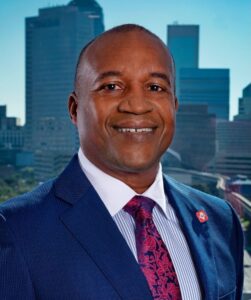 2 min read February 2022 — In an interview with Invest:, Nathaniel Ford, CEO of Jacksonville Transportation Authority, talked about the recent success of the JTA and some of the challenges it had to overcome over the course of the pandemic as people no longer commuted to work and questioned the safety of public transportation. Ford also talked about the Urban Circulator, its MOVE plan and the innovations related to automation that the authority foresees in the future as it relates to transportation.
2 min read February 2022 — In an interview with Invest:, Nathaniel Ford, CEO of Jacksonville Transportation Authority, talked about the recent success of the JTA and some of the challenges it had to overcome over the course of the pandemic as people no longer commuted to work and questioned the safety of public transportation. Ford also talked about the Urban Circulator, its MOVE plan and the innovations related to automation that the authority foresees in the future as it relates to transportation.
What have been some highlights or milestones for JTA?
The biggest milestone for the JTA was the recent passage of a local option gas tax extension and expansion to fund $1 billion worth of capital infrastructure transportation related projects for the city of Jacksonville. Along with that, we had the opening of the Jacksonville Regional Transportation Center, a 67,000-square-foot headquarters for the JTA administrative offices as well as a regional transportation center for Northeast Florida, where transportation services converge. As of Sept. 27, we now have the largest bus rapid transit network in the Southeast, the First Coast Flyer. We also have a number of road projects we completed in the past few months through our JTAMobilityWorks program. I’d say it has been a successful period despite the challenges we still face with COVID-19.
What are some challenges the JTA faced while working through the pandemic?
We had to prioritize the safety of our workforce and our customers. We were concerned about employee safety, and we needed to ensure they had the proper protective equipment and safety protocols in place to do their jobs. We had to bolster our sanitation protocols inside our facilities and on board our vehicles, to visibly show we were taking every precaution possible. As the pandemic evolved, we prioritized keeping employees and customers informed about the state of the pandemic and what resources were available to them. We sourced materials locally to support local businesses, and still use these practices as we are entering the tail end of the pandemic.
Thankfully, we already had protective measures like touchless payment systems on board, and protective barriers that provide an added layer of separation. That allowed us to continue charging fares during the pandemic. We built JRTC at LaVilla with advanced filtration systems; however, we identified ways to further upgrade those systems.
I would say that the pandemic gave us the opportunity to engage professionals and discuss our MOVE plan, which stands for mobility optimized through vision and excellence. Phase 1 of that plan identified where we could lean into supporting the community during the pandemic. We developed Wellness on Wheels to help people get to COVID-19 testing. We later pivoted to converting several buses into mobile vaccination clinics to bring the COVID-19 vaccine to people who either didn’t feel safe leaving their homes or didn’t have the ability to. We have looked at how to support the community through transportation infrastructure and over the next several years as we enter Phase 2 of MOVE, we are looking at what services we can provide for what will be a completely different community with different needs and who will utilize public transportation differently. The future is bright and we’ve already begun our plans to support an evolving community.
How has public transit been perceived throughout the pandemic?
We did suffer a significant drop in ridership like most of the industry did in 2020. With so many working from home, a lot of our riders were not there for us because they didn’t need the service as frequently as they once did. Even with that decline, we never suspended service because we knew there were around 12,000 – 18,000 people who had no other transportation besides the JTA. I believe we were seen as being resilient in many ways, especially for those who still depended on public transit such as essential healthcare and grocery store workers.
The industry has been tested to an extent not seen in our lifetimes, but we stood up to that challenge and showed once again why public transportation is a backbone in the communities we serve like Jacksonville.
What is the time frame for completing the Urban Circulator and what does this project mean for Jacksonville?
We are living in probably the most transformative time in our recent history as it relates to mobility. The Ultimate Urban Circulator project for the JTA will replace the obsolete Skyway system to provide services to the community through autonomous vehicles over a 10-mile system. We are excited about this project. Outside of the U2C, we are already using the technology in many different ways through our Test & Learn program. We are working with Florida State College at Jacksonville and Duval County Public Schools to introduce this technology and to prepare the workforce of the future to work with this technology. The work we’re doing today will benefit the community long term.
Phase I of the U2C project is in active development and we expect to be on the street within the next 3 years. Phase II, which is the full conversion of our Skyway system, is about seven years out, and Phase III – our neighborhood extensions, will be completed shortly after.
In the meantime, we’ll continue to partner with schools, medical campuses and other stakeholders to identify our Agile Plans, and other uses for the technology through our Test & Learn program.
For more information, visit:
